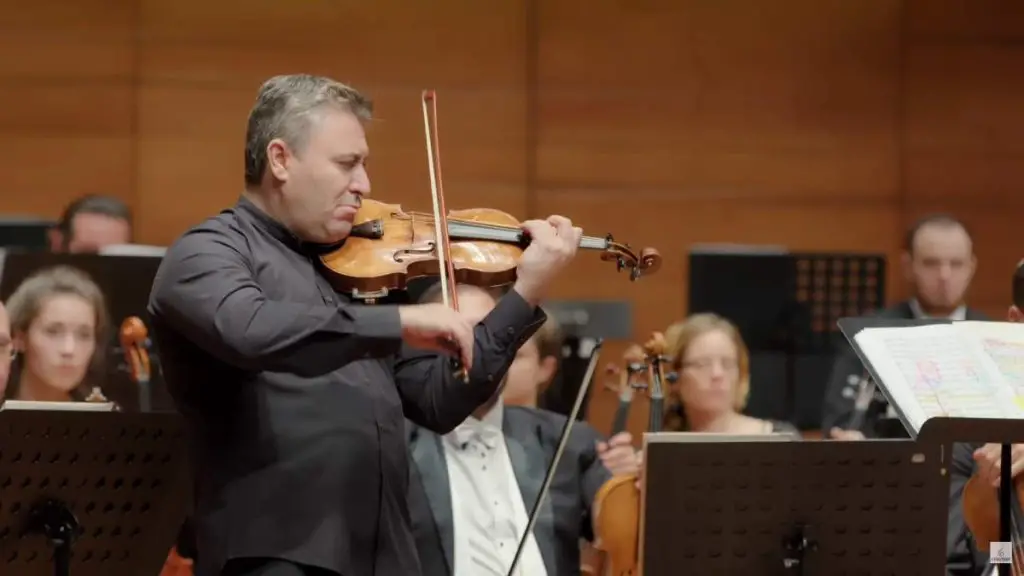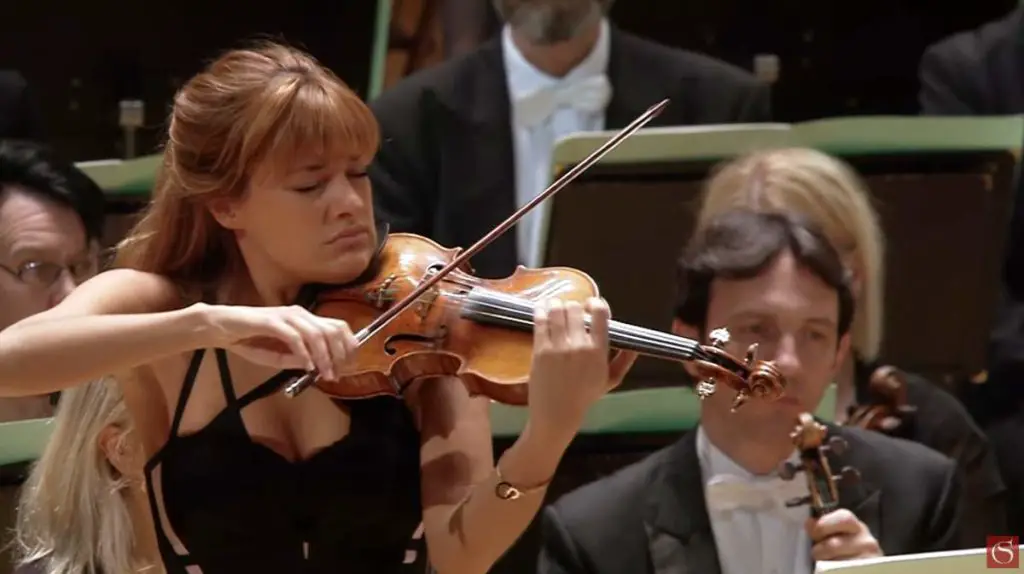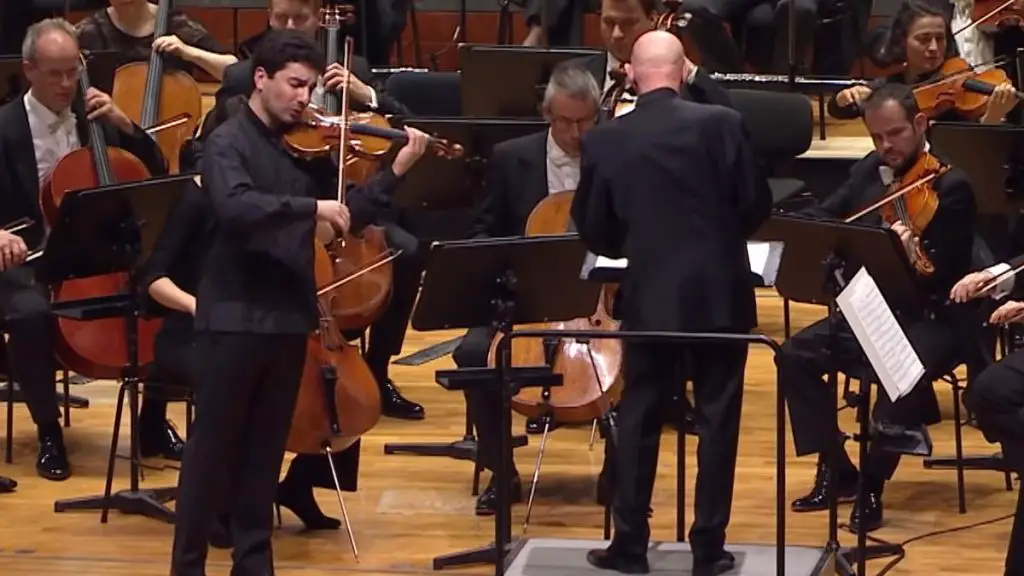Accompanied by the Novosibirsk State Philharmonic Orchestra, Maxim Vengerov performs Dmitri Shostakovich’s Violin Concerto No. 1 in A minor, Op. 77. Conductor: Thomas Sanderling, a Shostakovich specialist, and principal conductor and artistic director of the orchestra. Recorded at the at Arnold Kats State Concert Hall, Novosibirsk, on September 3, 2019.
Shostakovich’s Violin Concerto No. 1
Dmitri Shostakovich’s Violin Concerto No. 1 in A minor, Op. 77, is a monumental work in the violin repertoire, originally composed in 1947-48. However, it wasn’t publicly performed until 1955, primarily due to the cultural and political atmosphere of the Soviet Union at the time. It’s important to understand that Shostakovich was often walking a fine line between creative expression and state-approved artistry, especially given the authoritarian regime under Joseph Stalin.
The concerto is a deeply personal work for Shostakovich and is imbued with a variety of emotional textures. Shostakovich had a knack for capturing the complex range of human emotion, and this concerto is no exception. It’s often seen as an emotional autobiography of the composer, whose life was marked by both artistic brilliance and political peril. The work incorporates a range of moods, from introspective and somber to frenzied and exuberant.
David Oistrakh, the eminent Soviet violinist, was the dedicatee of this concerto and its first performer. Oistrakh’s technique and emotional depth were key factors in shaping the piece, and his collaboration with Shostakovich was critical for bringing the concerto to life. In fact, the concerto was initially kept ‘in the drawer’ until it was safe to premiere, which came after Stalin’s death and the subsequent slight easing of cultural restrictions. Oistrakh’s premiere performance was met with critical acclaim, solidifying the work’s place in the canon of great violin concertos.
The work is scored for solo violin and a relatively large orchestra, which includes a wide array of instruments, adding depth and color to the overall texture. The orchestration helps bring out the nuances of the violin’s narrative, providing a lush, but sometimes also stark, backdrop against which the violin unfolds its story.
Shostakovich integrates various musical techniques, including themes and motifs that recur in various forms, offering listeners an intricate tapestry of sound that rewards close attention. Themes of struggle, hope, and despair are interwoven, reflecting not just the composer’s personal experiences but also the broader human condition.
The concerto has influenced subsequent generations of composers and performers alike. Its technical demands and emotional depth make it a challenging but rewarding piece to master for any violinist. The work has been interpreted by many great violinists since Oistrakh, each bringing their own nuances to this complex and multi-faceted piece.
Movements
1. Nocturne: Moderato
The first movement of Dmitri Shostakovich’s Violin Concerto No. 1, titled “Nocturne,” is characterized by its brooding, introspective nature. Written in A minor, it establishes a deeply emotional atmosphere right from the beginning, setting the stage for the entire concerto. Often described as a “night piece,” the Nocturne evokes a sense of solitude and contemplation.
The movement starts softly, with the solo violin playing a simple, melancholic melody that is soon joined by the orchestra. The orchestral accompaniment is subdued, allowing the violin to be the central voice narrating this quiet drama. The string section and woodwinds create a background that alternates between atmospheric and poignant, but the primary focus remains on the violin.
The harmonic language of the movement reflects Shostakovich’s ability to mesh traditional tonality with modern dissonances. The orchestration is sparse, yet carefully crafted to highlight the tonal colors of individual instruments, particularly the solo violin. This lends an intimacy to the movement that makes it a powerful experience for both performers and listeners.
The solo violin part is technically demanding, not because of fast passages or complicated rhythms, but because of the emotional depth required to interpret the music authentically. It’s a movement that demands not just technical proficiency but also a nuanced understanding of its underlying emotional content.
Thematically, the Nocturne can be seen as a representation of personal or even collective introspection. Given Shostakovich’s experiences during a repressive political era, the movement may be reflective of broader existential questions. However, the music’s emotional and interpretive openness also allows for a wide range of individual listener experiences.
In the context of the entire concerto, the Nocturne serves as an emotional foundation, preparing the listener for the varied states of mind that are to be explored in the subsequent movements. It invites the listener into the inner world of the composer or the performer and serves as a meditative starting point for the journey through the rest of the work.
2. Scherzo: Allegro
The second movement of Shostakovich’s Violin Concerto No. 1 is titled “Scherzo,” and as the name suggests, it’s a fast-paced movement that stands in stark contrast to the reflective and introspective nature of the “Nocturne,” the first movement. The Scherzo is energetic, almost frenetic, and imbued with a sense of urgency. It showcases the virtuosic capabilities of the violinist, requiring both technical prowess and emotional commitment to fully realize its complexities.
The music in this movement is rhythmically intense, filled with syncopations and abrupt changes that keep both the performer and the listener on their toes. The orchestration is more elaborate here compared to the first movement, utilizing the full range of the orchestra to create a robust sound palette. This gives the movement a more extroverted character, though not without a hint of the dark undertones that are a hallmark of Shostakovich’s oeuvre.
The violin part is particularly challenging, featuring rapid passages, intricate fingerwork, and sudden dynamic changes. The thematic material is presented and then developed with vigor, undergoing transformations that imbue the movement with a sense of drama. While the tempo and mood might suggest a playful atmosphere on the surface, there is an underlying tension that permeates the music, creating a complex emotional landscape.
The harmonic language is adventurous, with Shostakovich employing a mix of tonality and dissonance to propel the music forward. The melodic lines are often fragmented, passed between the solo violin and different sections of the orchestra, creating a dialogue that adds to the movement’s intense, almost confrontational, demeanor.
Given the historical and political context in which Shostakovich was composing, the Scherzo can also be interpreted as a portrayal of the anxiety and upheaval of the time. It reflects the struggle between individual expression and collective constraints, a theme recurrent in much of Shostakovich’s work.
3. Passacaglia: Andante – Cadenza (attacca)
The third movement of Dmitri Shostakovich’s Violin Concerto No. 1 is called “Passacaglia,” and it serves as the emotional and structural core of the entire work. In contrast to the fast-paced intensity of the second movement, “Scherzo,” the Passacaglia is solemn and deeply expressive. This movement employs the Baroque passacaglia form, traditionally a set of variations over a repeated bass line, and transforms it into a modern vehicle for emotional exploration.
The movement opens with an orchestral introduction, presenting the foundational theme—a sequence of eight chords—that will be varied throughout. The solo violin enters after this initial statement, beginning its own set of variations on the theme. The relationship between the solo violin and the orchestra is one of partnership and dialogue, as they together weave a complex emotional tapestry.
The thematic material is developed through a series of variations that grow in complexity and emotional weight. While the pace remains generally slow and deliberate, the intensity ebbs and flows, capturing a vast emotional range. The passacaglia form allows Shostakovich to explore the depths of human feeling in a structured way, from despair to a kind of restrained hope or resignation.
The orchestration is rich and dense, providing a sonorous backdrop against which the violin can articulate its emotional journey. This is a movement that requires deep emotional commitment from the performer, as the music ventures into territory that is both personal and universally human. The violin part is highly expressive but not overtly virtuosic in the way the second movement is; the challenges here are interpretive more than they are technical.
The harmonic language is deeply chromatic, filled with dissonances that resolve in unexpected ways, contributing to the movement’s sense of struggle and yearning. Despite the complex harmonies, the recurring passacaglia theme provides an anchor, grounding the listener as the music traverses its emotional landscape.
Many interpreters see the “Passacaglia” as a reflection of Shostakovich’s own emotional and existential struggles, as well as a comment on the trials of the human condition more broadly. The movement has a timeless quality, capturing feelings and themes that resonate far beyond the specific historical and political circumstances in which it was composed.
4. Burlesque: Allegro con brio – Presto
The finale of Shostakovich’s Violin Concerto No. 1 is known as the “Burlesque,” and it serves as a dramatic and energetic conclusion to the entire work. After the deeply introspective and solemn atmosphere of the preceding “Passacaglia,” the Burlesque comes as a stark contrast, bursting with vitality and rhythmic drive.
The music in this movement is characterized by its rhythmic complexity and brisk tempo. It opens with a sense of urgency and propels itself forward with relentless energy. The solo violin part is highly virtuosic, filled with rapid passages, sharp articulations, and challenging double stops. This is a movement that demands technical agility from the performer, requiring not just speed but also precision and interpretive flair.
While the title “Burlesque” might imply humor or satire, the music here is not light-hearted in a conventional sense. The mood is more sardonic than jovial, tinged with irony and biting wit. Some interpretations suggest that this edginess might be a reflection of Shostakovich’s own experiences living under a repressive regime, where humor often carried with it a sense of risk or subversion.
The orchestration in the Burlesque is robust and colorful, utilizing the full orchestra to create a rich tapestry of sound. Brass and percussion play a significant role, punctuating the music with sharp accents and rhythmic emphasis. The orchestra works in close dialogue with the solo violin, sometimes echoing its themes and at other times providing contrasting material that enriches the musical texture.
The harmonic language is adventurous and dissonant, further contributing to the movement’s sense of urgency and tension. The movement does not provide easy resolutions; instead, it maintains its relentless pace up to its final moments, concluding the concerto on a note of exhilarating, yet complex, optimism.
The Burlesque serves as an emphatic ending to a concerto that traverses a wide emotional and musical terrain. It offers a counterpoint to the introspection and melancholy of the earlier movements, while still being rooted in the complex emotional landscape that Shostakovich so masterfully explores throughout the work.
Sources
- Violin Concerto No. 1 (Shostakovich) on Wikipedia




